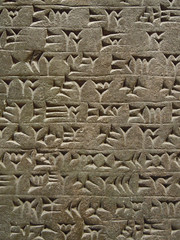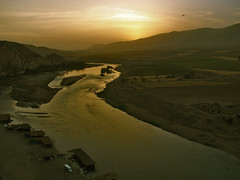From Hunting and Gathering to Civilizations, 2.5 million-1000 B.C.E.: Origins
Original from MrsBHatchTEACHER
| 6615788731 | hunting and gathering | Means of obtaining subsistence by humans before the mastery of sedentary agriculture; normally typical of tribal social organization |  | 0 |
| 6615788732 | civilization | Societies with reliance on sedentary agriculture, ability to produce food surpluses, and existence of nonfarming elites, along with merchant and manufacturing groups | 1 | |
| 6615788733 | neolithic | The New Stone Age between 8000 and 5000 B.C.E.; period in which adaptation of sedentary agriculture occurred; domestication of plants and animals accomplished |  | 2 |
| 6615788734 | nomadic societies | livestock hearding societies that do not have a permanent settlement. normally found on the fringes of civilized (urban) societies; commonly referred to as "barbarian" by civilized societies |  | 3 |
| 6615788735 | culture | Combination of ideas, objects, and patterns of behavior that result from human social interaction |  | 4 |
| 6615788736 | agrarian revolution | Occurred between 8000 and 5000 B.C.E.; transition from hunting and gathering to sedentary agriculture |  | 5 |
| 6615788737 | pastoralism | A nomadic agricultural lifestyle based on herding domesticated animals; tended to produce independent people capable of challenging sedentary agricultural societies |  | 6 |
| 6615788738 | Catal Huyuk | Early urban culture/civiization based on sedentary agriculture; located in modern southern Turkey; larger in population than Jericho, had greater degree of social stratification |  | 7 |
| 6615788739 | Bronze Age | From 4000 to 3000 B.C.E.; increased use of plow, metalworking; development of wheeled vehicles, writing |  | 8 |
| 6615788740 | Mesopotamia | Literally "between the rivers"; the civilization that arose in the alluvial plain of the Tigris-Euphrates river valleys |  | 9 |
| 6615788741 | potter's wheel | A technological advance in pottery making; invented circa 6000 B.C.E.; encouraged faster and higher-quality ceramic pottery products |  | 10 |
| 6615788742 | Sumerians | People who migrated into Mesopotamia circa 4000 B.C.E.; created the first civilization within the region; organized area into city-states |  | 11 |
| 6615788743 | cuneiform | A form of writing developed by the Sumerians using a wedge-shaped stylus and clay tablets |  | 12 |
| 6615788744 | city-state | A form of political organization typical of Mesopotamian civilization; consisted of agricultural hinterlands ruled by an urban-based king |  | 13 |
| 6615788745 | ziggurat | a massive tower building usually associated with Mesopotamian temple connections |  | 14 |
| 6615788746 | Babylonian Empire | Unified all of Mesopotamia circa 1800 B.C.E.; collapsed due to foreign invasion circa 1600 B.C.E. |  | 15 |
| 6615788747 | Hammurabi | The most important Babylonian ruler; responsible for codification of the law |  | 16 |
| 6615788748 | Pharaoh | The term used to denote the kings of ancient Egypt; the term, "great house" refers to the palace of the pharaohs |  | 17 |
| 6615788749 | pyramids | Monumental architecture typical of Old Kingdom Egypt; used as burial sites for pharaohs |  | 18 |
| 6615788750 | hieroglyphs | Form of writing developed in ancient Egypt; more pictorial than Mesopotamian cuneiform |  | 19 |
| 6615788751 | Kush | African state that developed along the upper reaches of the Nile circa 1000 B.C.E.; conquered Egypt and ruled it for several centuries | 20 | |
| 6615788752 | monotheism | The exclusive worship of one god; introduced by Jews into Middle Eastern civilization |  | 21 |
| 6615788753 | Phoenicians | Seafaring civilization located on the shores of the eastern Mediterranean; established colonies throughout the Mediterranean |  | 22 |
| 6615788754 | Harappa and Mohenjo Daro | Major urban complexes of Harappan civilization; laid out on planned grid pattern |  | 23 |
| 6615788755 | Aryans | Indo-European nomadic, warlike, pastorialists who replaced Harappan civilization |  | 24 |
| 6615788756 | Huanghe (Yellow) River Basin | Site of the development of sedentary agriculture in China |  | 25 |
| 6615788757 | Shang | 1st Chinese dynasty (after the legendary Xia) |  | 26 |
| 6615788758 | Oracles | Shamans or priests in Chinese society who foretold the future through interpreting animal bones cracked by heat; inscriptions on bones led to Chinese writing |  | 27 |
| 6615788759 | ideographic writing | Pictograph characters grouped together to create new concepts; typical of Chinese writing | 28 | |
| 6615788760 | Big Geography | A term that draws attention to the global nature of world history. |  | 29 |
| 6615788761 | Paleolithic | The period that ended about 3,000 years after the end of the last Ice Age, it lasted until about 10,000 years ago. (Old Stone Age) The period of the Stone Age associated with the evolution of humans. It predates the Neolithic period. |  | 30 |
| 6615788762 | Human migration during Paleolithic era | movement of humans from Africa to Eurasia, Australia, and the Americas | 31 | |
| 6615788763 | eglitarian | equality among people (no social levels) | 32 | |
| 6615788764 | tools | Humans developed a wider range of ____ specially adapted to different environments from tropics to tundra | 33 | |
| 6615788765 | Neolithic Revolution | period of change from hunter-gatherer lifesyle to agricultural lifestyles associated with domestication, farming, and settlement |  | 34 |
| 6615788766 | patriarchy | father based/male dominated society |  | 35 |
| 6615788767 | climatic change | Permanent agricultural villages emerged first in the lands of the eastern Mediterranean, possibly as a response to what? | 36 | |
| 6615788768 | weapons | Pastoralists were often the developers and disseminators of of ____ and forms of transportation that transformed warfare in agrarian civilizations | 37 | |
| 6615788769 | horses | name one mode of new transportation by the pastoralists | 38 | |
| 6615788770 | art | Elites, both political and religious, promoted ____. | 39 | |
| 6615788771 | record-keeping systems | ___ arose independently in all early civilization sand subsequently were diffused | 40 | |
| 6615788772 | Nile River | This river flooded regularly. |  | 41 |
| 6615788773 | Tigris River | This river's floods were unpredictable. |  | 42 |
| 6615788774 | Mesopotamian | Unpredictable weather patterns affected the development of the _____ civilization. | 43 | |
| 6615788775 | Egyptian | _______art demonstrated little change for nearly 1000 years. | 44 | |
| 6615788776 | Nubia and Kush | Kingdoms upriver from Egypt. | 45 | |
| 6615788777 | Standard of Ur |  | 46 | |
| 6615788778 | Harappan King or Priest Figure |  | 47 | |
| 6615788779 | Jericho | One of the earliest cities: located in modern Israel. |  | 48 |
| 6615788780 | Catal-Hyouk | One of the earliest cities: located in modern Turkey. | 49 | |
| 6615788781 | Papyrus | a material prepared in ancient Egypt from the pithy stem of a water plant, used in sheets throughout the ancient Mediterranean world for writing or painting on and also for making rope, sandals, and boats. | 50 | |
| 6615854692 | Mandate of Heaven | The Chinese philosophical concept of the circumstances under which a ruler is allowed to rule. | 51 | |
| 6615862602 | Hittite | a member of an ancient people who established an empire in Asia Minor and Syria that flourished from c. 1700 to c. 1200 BC. | 52 | |
| 6615869219 | Hatshepsut | Hatshepsut ( meaning Foremost of Noble Ladies; 1507-1458 BC) was the fifth pharaoh of the Eighteenth Dynasty of Egypt. | 53 | |
| 6615880066 | Akhenaten | Akhenaten, known before the fifth year of his reign as Amenhotep IV, was an Ancient Egyptian pharaoh of the 18th Dynasty who ruled for 17 years and died perhaps in 1336 BC or 1334 BC. | 54 | |
| 6615891387 | Ramesses II | Ramesses II, also known as Ramesses the Great and Ozymandias, was the third pharaoh of the Nineteenth Dynasty of Egypt. He often is regarded as the greatest, most celebrated, and most powerful pharaoh of the Egyptian Empire. | 55 | |
| 6615895781 | Ashurbanipal | Ashurbanipal, also spelled Assurbanipal or Ashshurbanipal, was an Assyrian king, the son of Esarhaddon and the last strong king of the Neo-Assyrian Empire. | 56 | |
| 6615908022 | Israel | Israel, a Middle Eastern country on the Mediterranean Sea, is regarded by Jews, Christians and Muslims as the biblical Holy Land. Its most sacred sites are in Jerusalem. | 57 | |
| 6615919713 | Cyrus the Great | Cyrus II of Persia, commonly known as Cyrus the Great and also called Cyrus the Elder by the Greeks, was the founder of the Achaemenid Empire. | 58 | |
| 6615922783 | Ideology | a system of ideas and ideals, especially one that forms the basis of economic or political theory and policy. | 59 | |
| 6615925587 | Royal Road | an ancient highway reorganized and rebuilt by the Persian king Darius the Great of the Achaemenid Empire in the 5th century BC. | 60 | |
| 6615930034 | Polynesian | Polynesia is a subregion of Oceania, made up of over 1,000 islands scattered over the central and southern Pacific Ocean. | 61 | |
| 6615940204 | Hebrew Bible | Hebrew Bible or Hebrew Scriptures is the term used by biblical scholars to refer to the Tanakh, the canonical collection of Jewish texts, which is the common textual source of several canonical editions of the Christian Old Testament. | 62 | |
| 6615941687 | Phoenicians | an ancient civilization composed of independent city-states which lay along the coast of the Mediterranean Sea stretching through what is now Syria, Lebannon and northern Israel. | 63 |

